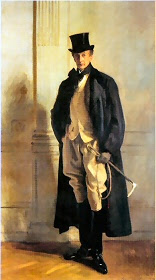Basil Seal Takes Manhattan, but gives it back...

Thursday Feb. 22: I landed at Teterboro and was met by the car sent for me by friend Fiendish. Well, actually I was met by the driver, and was introduced to the car a bit later, but anyway... Made the proverbial beeline for the NYAC, club of Fiendish (somewhere in NYC), who so graciously insisted that I stay as his guest. Arrived and was established in my room by a very charming staff and made welcome and comfortable by all. Very nice.

It was now time for luncheon. I went downstairs and found The Fiendish One and Mr. P waiting for me in the dining room. Mr. P had arrived after dropping Mrs. P into the bosom of her family, she was dropping in reluctantly I do believe, but being a good sport had given Mr. P his B & C liberty chit for 48 hours. This was my first face-to-face with Mr. P, as you all know I have lunched with Mrs. P, and had spoken to Mr. P briefly on the telephone. I say briefly due to the fact that the phone was slapped from the ear of Mr. P in mid-utterance by a minute-minding Mrs. C. So, we picked up where we had left off, as men do...This was the first actual meeting of the RCBfA, so The Fiendish One feted us in true New York style, and I must say that I am very fond of New York style, since he also picked up the tab. Hey, I heart NY too... I was very excited to be in the city. I asked Fiendish if we would be able to see a policeman display his superior wrist-work with his nightstick on some homeless people, or maybe some pimps and pushers, you know real desperate types, like maybe a bond trader or trial attorney. Mr. P being from Detroit was very familiar with mayhem and murder, so he said it would be best to skip all that boring stuff and shuffle off straight to the pubs (I like Mr. P). But we would try and spot some interesting people, places and things and gawk like farmers on the way. The Fiendish One, who I must say is a very big wheel in the justice system of NYC, I mean, when he is out of the office jurisprudence in NYC waits until he gets back, had to dash back to his office to set things straight but would meet up with us before the serious drinking began. So, The Fiendish One left his car and driver at our disposal and tootled off and Mr. P and I prepared for our first stop: The collection of Mr. Cusack...We were dressed by the best tailors, tanned, rested and ready for the city...

Later on Thursday, the offices of TNC (somewhere in NYC): I wasn't sure what to expect at the offices of this highly influential publication. I suppose I expected an outer lair where Pugsy Maloney sits near the door of the inter sanctum and wards off unwanted visitors. I expected to get the once over from Kid Brady as well. But in reality it is a simple, modern office space with very nice windows. It has somewhat the feel of a "loft" space with hardwood floors. I was excited at this chance to meet my heroes in the flesh; Mr. Kimball, Mr. "Boy Mulcaster" Panero, Mr. Yezzi, Cricket Farnsworth...former TNCer Mr. Beck as well, but we would have more luck running into him in a pub...But alas, when we arrived Mr. Cusack informed us that he had mentioned the impending visit of an esteemed subscriber by the name of Seal at around 3pm, and at 3:10pm he was alone in the office...Something about previous engagements or something. Well anyway, one gets used to it...We toured the offices, I sat in Mr. Kimball's chair, to get a view from the top, if only for a moment. I took one of the books from the box near Mr. Panero's desk and left it with a note to "please sign for Basil Seal" on his chair. We'll see if I ever get that...Mr. Cusack, the assistant editor of TNC and the former sub-editor of Cozy Moments has a very nice cubicle which he shares with the office fridge. Pretty convenient for him if you ask me. I took to Mr. Cusack right away, he is simply a delightful young man, and on this day, dressed in a tweed suit, even though we were in the city. Maybe an American thing, I don't know. Made me feel right at home, and since he was educated in the UK, we were able to converse with no trouble at all. I really wanted to meet Cricket Farnsworth for the simple reason that I wanted to meet someone named Cricket, and because she has always given me the brush-off in the nicest way when I called. But since she was not there I graded the child art near her desk and we departed the offices of TNC a little richer for the experience. By the way, I'm not sure what Mr. P was doing all this time. This was all old hat to him and he seemed to just be wondering about looking in drawers and scribbling in a notebook, tearing off a sheet and placing it in a drawer. Maybe it's an American thing...
Thursday evening, Friday morning, NYAC, The Players, Chumleys, Fraunces, face down on boot of police car (somewhere in NYC): To be continued...









































